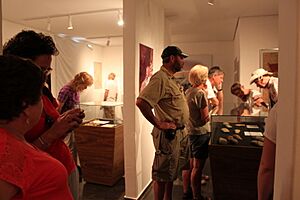Annette Laming-Emperaire facts for kids
Quick facts for kids
Annette Laming-Emperaire
|
|
|---|---|
| Born | 22 October 1917 |
| Died | May 1977 (aged 59–60) |
| Nationality | French |
| Occupation | Archeologist |
Annette Laming-Emperaire (born October 22, 1917 – died May 1977) was a famous French archeologist. She was born in Petrograd, Russia. Her parents were French diplomats. Just before the Bolshevik Revolution, her family moved to France.
Annette first studied philosophy in Paris. When World War II started, she became a teacher. She also joined the French Resistance, fighting against the occupation. After the war, she began studying archaeology. She became an expert in ancient cave art. Her important book, La Signification de l’art rupestre paléolithique, was published in 1962. In this book, she showed new ways to study cave art. She looked closely at how animals were grouped in caves. She also studied their gender, how often they appeared, and their positions. This method is still used by archeologists today.
Contents
Exploring South America
Annette married another archeologist named Joseph Emperaire. He believed that early humans came to South America from Asia. Together, they started looking for signs of ancient human life. They dug at sites in Brazil, Argentina, and Chile. Sadly, Joseph died during one of these digs. A wall at an excavation site fell on him.
In the early 1970s, Annette returned to Brazil. She chose six sites in the Lagoa Santa area. A Danish scientist, Peter Wilhelm Lund, had explored this area a century earlier.
The Discovery of Luzia
Annette found a rock shelter at one of her sites. This was called site IV. In 1974-1975, she made an amazing discovery there. She found many bones of what was named Lapa Vermelha IV hominid 1. This was the oldest human fossil ever found in Brazil. It was about 11,000 years old! The skull from this fossil was given the nickname Luzia.
Annette Laming-Emperaire died tragically soon after this discovery. In 1976, she was on vacation in the Brazilian state of Paraná. She died from a faulty gas heater in her shower. After her death, work at the site stopped for a while. Later, her assistant, Andre Prous, continued the project.
A colleague described her as "one of the richest and most creative minds in French prehistoric research."
Annette's Legacy in Brazil
Annette Laming-Emperaire's work in the Lagoa Santa region is very important. This area includes several towns like Lagoa Santa and Pedro Leopoldo. Her findings are kept at the Archeology Center Annette Laming Emperaire (Caale). This center has been open for 35 years.
Annette's team included researchers from the National Museum. They found thousands of ancient pottery pieces, stone tools, and bones. The French-Brazilian mission worked in the region from 1974 to 1976. This project was supported by Unesco. They focused their digs mainly in the Lapa Vermelha cave in Pedro Leopoldo. This is the cave where Annette found "Luzia."
In 1998, "Luzia" was given a face. An anthropologist named Walter Neves studied the bones at the museum. He confirmed that Luzia was 11,400 years old. Experts say that Annette's mission helped the world remember how important Lagoa Santa is. Dr. Lund had collected over 12,000 fossils there in the 1800s. These were sent to the King of Denmark. After Lund, the area was not explored much until the 1950s. Then, researchers from the Minas Gerais Academy of Sciences and the National Museum in Rio de Janeiro started new excavations.
Chronology of her excavations
- 1801: Peter W. Lund, a Danish scientist, was born. He lived in Lagoa Santa for 46 years. He is known as the father of Brazilian paleontology, archaeology, and speleology.
- 1832: Lund made his first fossil discoveries in the caves and coves of Lagoa Santa.
- 1845: Lund sent his collection of fossils from Lagoa Santa to the King of Denmark.
- 1950: Researchers from the Mining Academy of Sciences and the National Museum in Rio de Janeiro began new digs in the region.
- 1974: The French-Brazilian Mission, led by Annette Laming-Emperaire, started digging in Lagoa Santa. They continued until 1976.
- 1975: Annette Laming found the skull of Luzia Woman in Lapa Vermelha IV. This was the oldest human fossil found in Brazil. Many other ancient items were also sent to the National Museum in Rio de Janeiro.
- 1998: Bioanthropologist Walter Neves and archaeologist André Prous studied Luzia's skull. They confirmed it was 11,400 years old.
See also
 In Spanish: Annette Laming-Emperaire para niños
In Spanish: Annette Laming-Emperaire para niños


